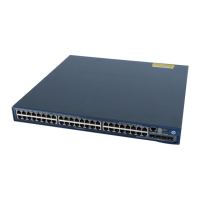81
If a port on a device that is running MSTP (or RSTP) connects to a device that is running STP, this port
automatically migrates to the STP-compatible mode. However, it will not be able to automatically migrate
back to the MSTP (or RSTP) mode, but will remain working in the STP-compatible mode under the
following circumstances:
The device that is running STP is shut down or removed.
The device that is running STP migrates to the MSTP (or RSTP) mode.
You can perform an mCheck operation to force the port to migrate to the MSTP (or RSTP) mode.
The following two methods for performing mCheck produce the same results.
Performing mCheck globally
Follow these steps to perform global mCheck:
Performing mCheck in interface view
Follow these steps to perform mCheck in interface view:
Enter Ethernet interface view or Layer 2
aggregate interface view
interface interface-type
interface-number
NOTE:
An mCheck operation takes effect on a device only when MSTP operates in RSTP or MSTP mode.
Configuring Digest Snooping
As defined in IEEE 802.1s, connected devices are in the same region only when their MST region-related
configurations (region name, revision level, VLAN-to-instance mappings) are identical. An MSTP-enabled
device identifies devices in the same MST region by determining the configuration ID in BPDU packets.
The configuration ID includes the region name, revision level, configuration digest, which is in 16-byte
length and is the result calculated via the HMAC-MD5 algorithm based on VLAN-to-instance mappings.
Because MSTP implementations vary with vendors, the configuration digests calculated via private keys
are different. The different vendors’ devices in the same MST region can not communicate with each
other.
Enabling the Digest Snooping feature on the port that connects the local device to a third-party device in
the same MST region can make the two devices communicate with each other.
NOTE:
Before you enable Digest Snooping, ensure that associated devices of different vendors are connected
and run MSTP.

